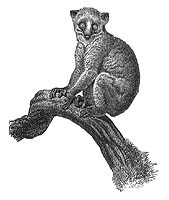The average body mass for this species is around 1100 grams. On the second digit of the foot there is a claw for grooming. The first digit on the hands face towards the other digits, and the second digit is reduced, thus the potto has a strong grip. The lower cervical and upper thoracic vertebrae are elongated, and these nuchal spines may be related to the musculature of the shoulders and arms (Jewell and Oates, 1969). The index finger is vestigial (Rowe, 1996). This species stores fat during the wet season so as to be able to better survive the dry season (Oates, 1984). The saliva of the potto has been found to contain volatiles, and biting may be a defensive strategy for this species (Alterman, 1995). This species has long, black guard hairs found from the crown to the scapular region (Walker, 1970). These guard hairs are specialized sensory hairs (Walker, 1970). The pelage of the potto is brownish overall (Rowe, 1996). The pelage of the vnetral side is lighter than that of the dorsal side (Ankel-Simons, 2000).
RANGE:
This species is found in the following countries: Benin, Burundi, Cameroon, Congo, Gabon, Ghana, Guinea, Ivory Coast, Kenya, Liberia, Nigeria, Rwanda, Sierra Leone, Togo, Uganda, and Zaire. The potto lives in the canopy of primary forests (Hladik, 1979). It has also been reported that this species lives in mountain forests and secondary forests (Pi, 1972). In secondary forests this species occurs at height from 30 to 40 feet (Jewell and Oates, 1969).
